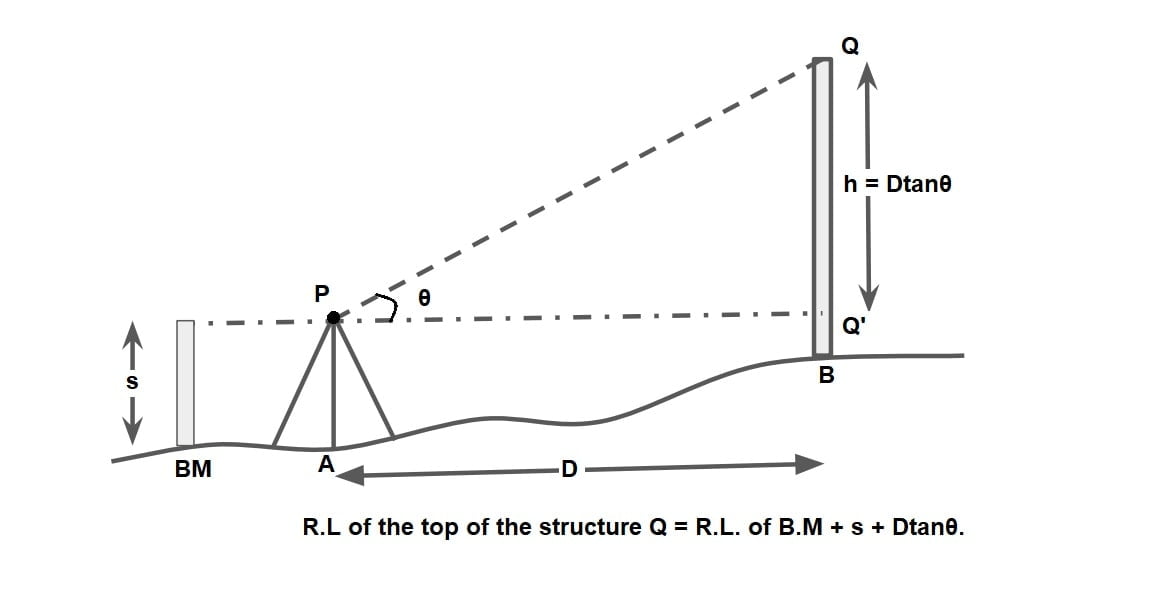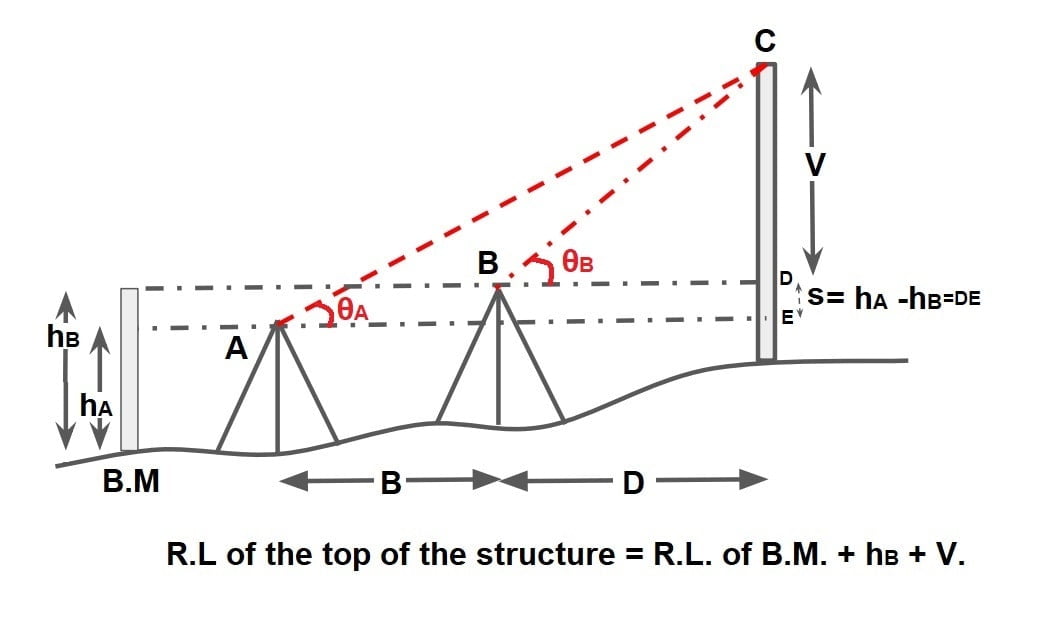Trigonometric Levelling
- It is an indirect method of levelling in which the relative elevation of various points are determined from vertical angle and horizontal distance measured with a theodolite and tape / chain / Tacheometer respectively.
- It is not as accurate as direct leveling but can be used for topographic work or where direct levelling is not possible.
- This technique if levelling work is usual to find a RL of any point which has elevation is very high / low.
- In these techniques after setting the instrument at any location first back sight reading is taken then angle of elevation is measured to the target.
1.Determination of elevation of object when its base is accessible.
Let the base B of the any structure (like: tower, chimney, etc) is accessible, and the horizontal distance D between the instrument station A and the base B can be measured using a tape. Let Q be the top of structure whose elevation is to be calculated.
 Set up the theodolite over A. Take a backsight on the B.M. and determine the height of instrument(s).
Set up the theodolite over A. Take a backsight on the B.M. and determine the height of instrument(s).
R.L. of the line of collimation = R.L. of B.M. + s
If the line of collimation intersects the structure at Q. the distance PQ’ is same as the horizontal distance D.
Sight the top of the chimney, and measure the angle of elevation θ.
In the triangle PQQ’.
QQ’=Dtanθ
h = Dtanθ
R.L of the top of the structure = R.L. of B.M. + s + Dtanθ.
2.Determination of elevation of object when its base is not accessible.
In this case instrument shift at two known locations and staff reading are taken to the Benchmark (BM) and vertical angle is measured to the target from both stations.
All three points [A, B, C] are in the same vertical plane.

from Δ ACE
CE = AE⋅tanθA
(V+S)= (B+D)⋅tanθA ….(1)
from Δ BCD
CD = BD⋅tanθB
V= D⋅tanθB ….(2)
In equation 1 & 2, V & D are unknow. There are two equation and two unknow so we calculate the value of V & D by solving the equation.
Note:
Higher the angle of elevation near is the instrument to the target.
Higher the back sight reading higher the elevation of the instrument at position.
3.Determination of elevation of the object when the two instruments are not in the same vertical plane.
The instrument stations A and B are not in the same vertical plane. And assume point C is the top point of the object. The procedure used is as follows:
- Set up the instrument over A. Measure the vertical angle ∠DAC= θA, Measure the horizontal angle ∠CAB= αA.
- Set up the instrument over B. Measure the vertical angle ∠EBC= θB, Measure the horizontal angle ∠CBA= αB.

Find the RL of Q
from Δ ACD on vertical plane
CD = AD⋅tanθA
h1= D1×tanθA ….(1) {Unknown is h1, D1}
from Δ BCE on vertical plane
CE = BE⋅tanθB
h2= D2×tanθB ….(2) {Unknown is h2, D2}
from Δ ABC on horizontal plane {Unknown is h2, D2}
{Unknown is D1, D2, & αC (αC = 180°-αA -αB) }
for D1, D2,
\(\frac{sin\alpha _A}{D_2}=\frac{sin\alpha _B}{D_1}=\frac{sin\alpha _C}{d}\) …(3)
D1, & D2, is calculated by equation 3. And for find the value of h1, put the value of D1 in equation 1. Same procedure for find the value of h2, put the value of D2 in equation 2.
RL of Q = RL of BM + hA + h1
hA =staff reading at BM when the instrument is at A
For checking purpose
RL of Q = RL of BM + hB + h2
hB =staff reading at BM when the instrument is at B